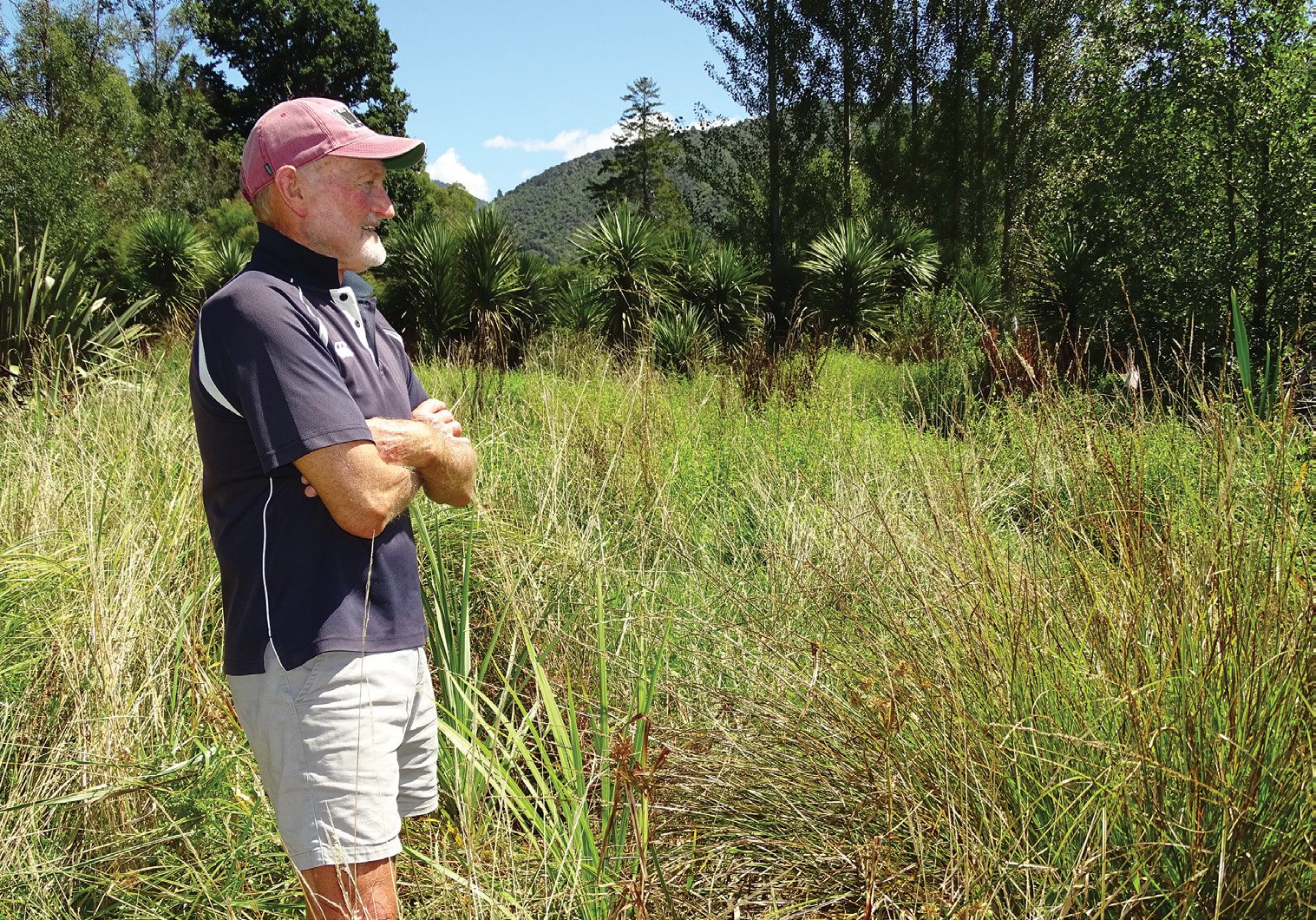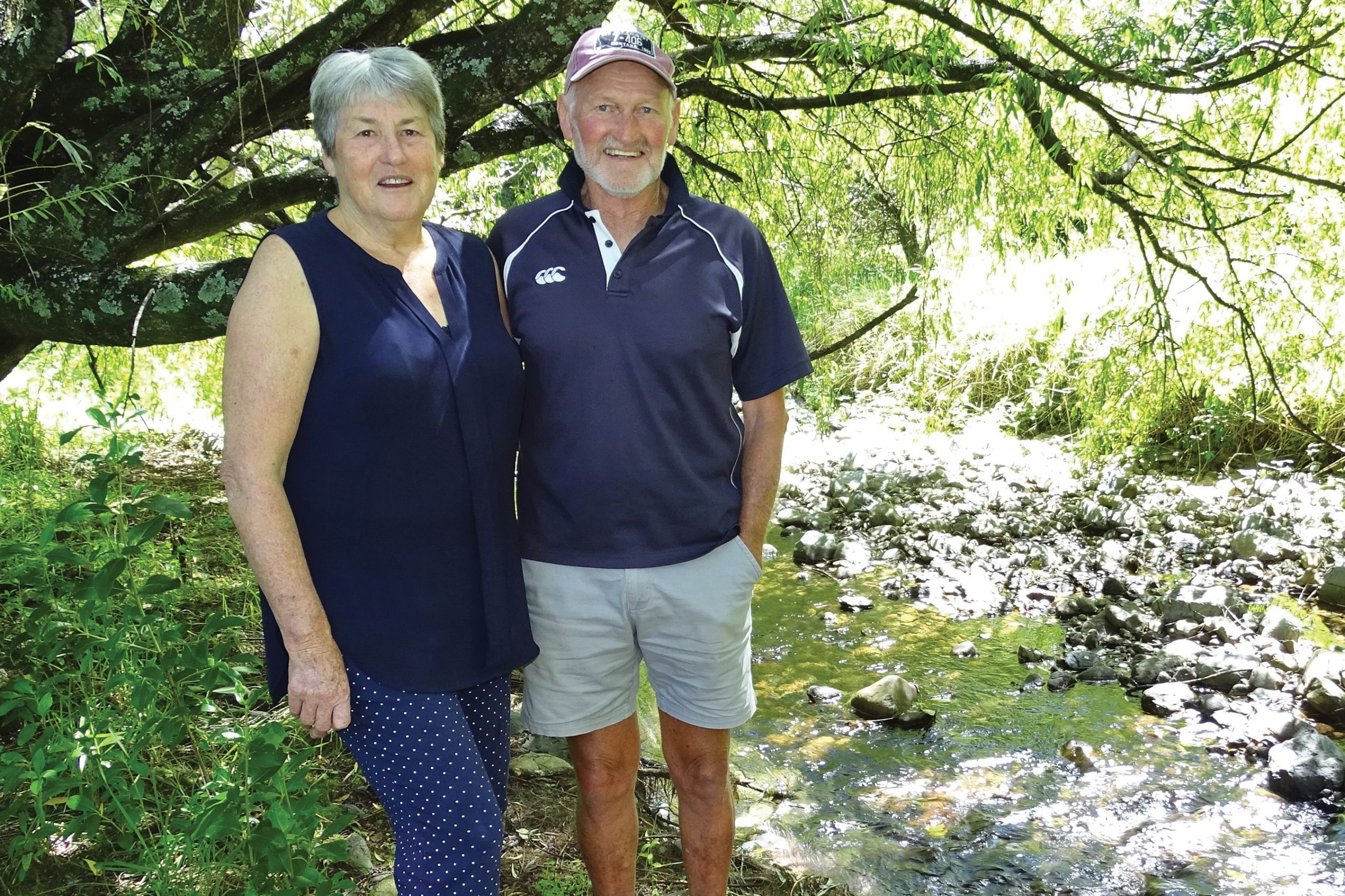Accommodating the effects of climate change on a Pelorus farm has seen the Richmonds cope with a series of floods.
In the 20 years Barbara and Bruce Richmond have farmed at Pelorus they have endured several floods including three 100-year floods. A hundred years is not what it used to be when it comes to floods.
They have planted many thousands of trees over the years along waterways, creating wetlands and also planting for biodiversity. They have also lost about 40% of their plantings to floods and “babbling brooks” that become raging torrents. So they plant again and budget for it each year.
Their 160 effective hectares flows down Marlborough hillsides to terraces and only the bottom terrace gets flooded by the Pelorus River. Though only the lower terrace floods where the Pelorus River overflows its banks and crosses the highway to their property, the volume of water and boulders tumbling down the streams can take a lot of land with them, including riparian fencing and plantings. One wetland they created on the lower terrace has been planted twice and much of it will need to be replanted again after the last flood in August ripped out plants.

Forestry and bush debris add to the damage along the banks and so the waterway is constantly changing its shape. On the farm’s boundary, the Pelorus River has changed even more dramatically and Bruce says the August flood scoured the bank back 20 to 30 metres in some places. It raises the question about whether there is any point planting some waterways that are continually being replanted.
“All our permanent waterways are now fenced and planted, though some of it isn’t practical.”
In recent times, the Te Hoiere- Pelorus Catchment Restoration Project has funded a good deal of the planting, fencing and ongoing maintenance on the farm and other properties throughout the catchment.
Like many landowners, protecting waterways with riparian plantings, replacing culverts and sometimes bridges, is an ongoing cost that needs to be built into the farm budget.
Over the years, they have earmarked between $3000 and $5000 each year for riparian planting. Fencing is an extra cost. They estimate the Te Hoiere project’s funding has saved them 10 to 12 years of planting and maintenance.
Barbara has recently become a community trustee of the Te Hoiere Kaitiaki Charitable Trust which has direct input into the strategy of the project. It involves the Marlborough District Council, Department of Conservation, Ngati Kuia and the wider community and has been chosen as an exemplar catchment by the Government.
Over the next few years it will work collaboratively with all landowners in the catchment, using funding from the Government and council to restore tributaries flowing into the Pelorus River and lift the water quality throughout. The goal is to use the catchment as a focal point for the rest of the country to find practical solutions to problems in waterways.
The collaborative approach means landowners are given direction, but Barbara says it also gives them a voice.
“You need to listen, but you need to be listened to as well,” she says. “Because it is a collaborative approach, so much can be addressed, knowing who you are working with and getting your point across.”
Barbara and Bruce have long been keen on enhancing the environment on the farm and have been planting trees for the past 20 years alongside making onfarm improvements. These days they are basically retired, though Bruce still helps out from time to time.
Their daughter and son-in-law, Jo Richmond and Kerrin Brown, have a 50:50 sharemilking contract with them and they in turn have a contract milker. Barbara and Bruce’s son Sam and wife Billi also live on the farm after buying the old homestead and a piece of land.
Stepping back in time to a little more than 20 years ago, Barbara and Bruce were teachers, living on a lifestyle block in the northern parts of Taranaki, when in their late 40s, a tiny dairy farm came on to the market next door and Bruce decided he would quite like to try that.
Barbara thought it was a crazy idea. They had a perfect life on a lifestyle block and were active with marathon running and biking. But Bruce was keen and so they bought the farm.
For the next five years, Bruce milked the 60-cow herd before heading off to school each day. At that stage he was deputy principal of the 300-pupil bilingual Waitara East School.
In the afternoon, a neighbour milked the herd and weekends were spent doing all the jobs that needed to be done through the week and preparing for the upcoming week. It was hectic, yet Bruce and Barbara still managed to train for an Ironman competition that entailed a 3.8km swim, 180km bike ride and 42km marathon. They had previously completed a Coast to Coast in the South Island and were up for another challenge or two.
When Jo and Kerrin became interested in joining a family dairy business, they needed a bigger farm and that was not going to be found in Taranaki within their price range. They looked further afield and found a 105ha farm at Pelorus, between Nelson and Blenheim. Much of the higher part of the farm was covered in gorse, broom and ragwort where sheep and deer grazed, leaving the lower terraces to milk 160 cows.
“It looked uninviting from the road,” Bruce remembers. “Dry, rocky and rough. But when we got to the highest point on the farm we decided it was the farm we wanted. We could see its potential.”
Initially, Bruce was on the farm by himself while Barbara finished up her teaching work in Taranaki and he remembers the first morning on the farm thinking: “shit, this is quite daunting”.
He got past the daunted stage and before long they had installed a water reticulation scheme to the upper part of the farm that enabled them to milk 240 cows pretty well straight away. Then a neighbouring 105ha property came on to the market with 75 effective hectares which was “way too soon and touch and go with finance”, but it was an opportunity to expand the existing farm that might never arise again.
Since then, they have milked up to 500 cows, though that has been reduced to between 430 and 450. It was a mainly Jersey herd, then became a Kiwi Crossbred herd and it is now heading back to Jersey for the higher milkfat payout.
Environmental improvements have been ongoing from the time they bought the farm. Early on, the council visited farms to judge what needed to be done to protect waterways and then discussed an affordable/achievable timeframe to get it done. Bruce says it worked well for farmers and their relationship with the council. It prompted the installation of two bridges at $100,000 each and numerous culverts.
About the same time, a new 40-bail rotary was built and effluent storage for 30 days which was sufficient at the time. A decade later regulations dictated they needed more storage and they added a 500,000-litre bladder.
Along the way, Fonterra worked out a farm environment plan and that led to planting some of the ephemeral streams on the farm that only carry water in the wetter months or heavy rainfall events.
Ten years ago they created the first wetland on the farm, fencing off a one-hectare chunk of wet and unproductive land against the highway that they planted in natives. Since then, they have created another couple of wetlands and native areas on land better suited for those plantings than dairy grazing. More areas on the farm are earmarked for plantings because they are wet or unproductive and will add biodiversity.
Bruce says the birdlife has increased exponentially with the numerous plantings over the years and at the latest count there were close to 50 species of birds.
The Te Hoiere project has had a huge financial and physical input into the work, including fencing, the initial plants and ongoing maintenance. The Ministry for the Environment’s Jobs for Nature programme provides a contractor and team to manage the plantings for the first two years to help get the plants established.
“If you don’t get in and weed those plants the first couple of years, you will lose a lot of them.”
In the new wetland, they have spent $6000 themselves to replant after floods tore most of the first plantings out and much of that will need replanting after the last flood.
“You have to be in the black to be green,” Bruce quips.
They had thought about fencing and planting about 2.5ha on the side of a steep stony terrace, but it would have cost about $25,000 to get the job done and they did not have the funds for that.
“Some years we just can’t spend much money on environmental things, but some years will be bigger than others. There’s the things that have to be done for regulations and that has to be part of the farm’s budget, then there’s other things that are done by choice.”
Nature is doing its part, with pittosporums, manuka and totara popping up in fenced-off areas and one of the contracting team suggests some of the difficult areas to get established might be best left to nature where the ideal plants will eventually take hold.
Besides the native plantings, Barbara and Bruce have planted hundreds of deciduous trees around the farm such as poplars, weeping willows, oaks and elders, partly for beautification and shade for stock, but also for the beneficial effect from decomposing leaves that create more organic matter for worms.
Their latest investment for the environment is dung beetles, with their first batch arriving in May last year. Bruce has worked out the beetles cost $12 each, but due to a subsidy from the Te Hoirere Trust, they will only pay $6000 for their four packages of beetles. It is estimated it will take 10 years for the beetles to multiply sufficiently to cover the entire farm and reach their full potential to aerate the soil and absorb nutrients.






